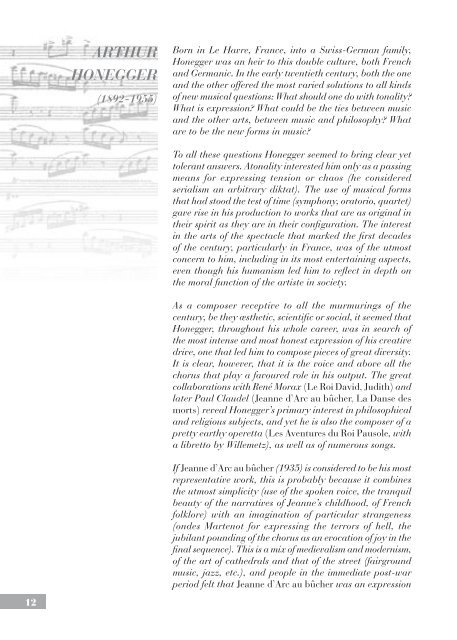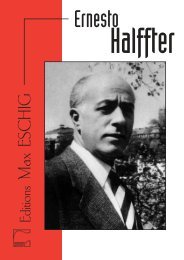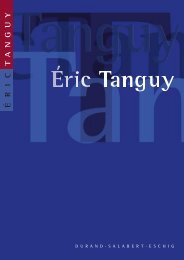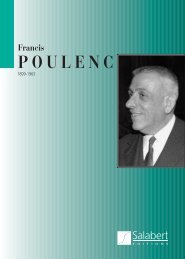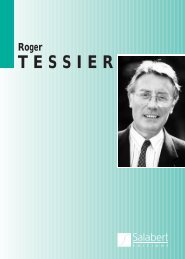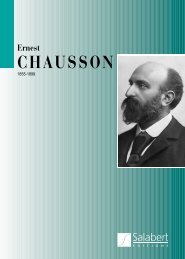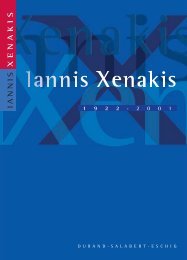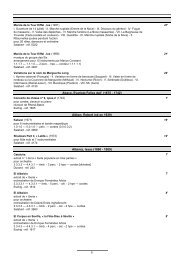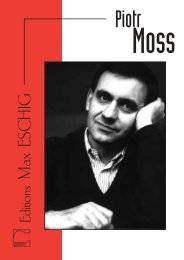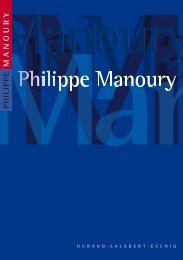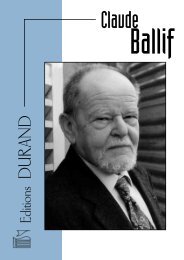Arthur Honegger - durand-salabert-eschig
Arthur Honegger - durand-salabert-eschig
Arthur Honegger - durand-salabert-eschig
Create successful ePaper yourself
Turn your PDF publications into a flip-book with our unique Google optimized e-Paper software.
ARTHUR<br />
HONEGGER<br />
(1892-1955)<br />
Born in Le Havre, France, into a Swiss-German family,<br />
<strong>Honegger</strong> was an heir to this double culture, both French<br />
and Germanic. In the early twentieth century, both the one<br />
and the other offered the most varied solutions to all kinds<br />
of new musical questions: What should one do with tonality?<br />
What is expression? What could be the ties between music<br />
and the other arts, between music and philosophy? What<br />
are to be the new forms in music?<br />
To all these questions <strong>Honegger</strong> seemed to bring clear yet<br />
tolerant answers. Atonality interested him only as a passing<br />
means for expressing tension or chaos (he considered<br />
serialism an arbitrary diktat). The use of musical forms<br />
that had stood the test of time (symphony, oratorio, quartet)<br />
gave rise in his production to works that are as original in<br />
their spirit as they are in their configuration. The interest<br />
in the arts of the spectacle that marked the first decades<br />
of the century, particularly in France, was of the utmost<br />
concern to him, including in its most entertaining aspects,<br />
even though his humanism led him to reflect in depth on<br />
the moral function of the artiste in society.<br />
As a composer receptive to all the murmurings of the<br />
century, be they æsthetic, scientific or social, it seemed that<br />
<strong>Honegger</strong>, throughout his whole career, was in search of<br />
the most intense and most honest expression of his creative<br />
drive, one that led him to compose pieces of great diversity.<br />
It is clear, however, that it is the voice and above all the<br />
chorus that play a favoured role in his output. The great<br />
collaborations with René Morax (Le Roi David, Judith) and<br />
later Paul Claudel (Jeanne d’Arc au bûcher, La Danse des<br />
morts) reveal <strong>Honegger</strong>’s primary interest in philosophical<br />
and religious subjects, and yet he is also the composer of a<br />
pretty earthy operetta (Les Aventures du Roi Pausole, with<br />
a libretto by Willemetz), as well as of numerous songs.<br />
If Jeanne d’Arc au bûcher (1935) is considered to be his most<br />
representative work, this is probably because it combines<br />
the utmost simplicity (use of the spoken voice, the tranquil<br />
beauty of the narratives of Jeanne’s childhood, of French<br />
folklore) with an imagination of particular strangeness<br />
(ondes Martenot for expressing the terrors of hell, the<br />
jubilant pounding of the chorus as an evocation of joy in the<br />
final sequence). This is a mix of medievalism and modernism,<br />
of the art of cathedrals and that of the street (fairground<br />
music, jazz, etc.), and people in the immediate post-war<br />
period felt that Jeanne d’Arc au bûcher was an expression<br />
12


